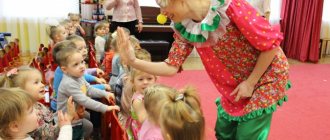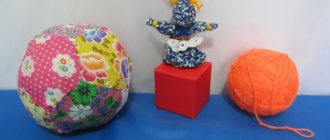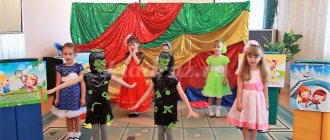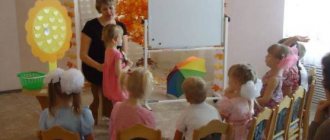“How to organize a themed day. New ideas for educators" consultation on the topic
Consultation for educators
“How to organize a themed day: new ideas” for a teacher
Compiled by: Sinyagaeva V.I.,
Art. teacher of MBDOU No. 38 “Golden Beehive”
Bugulma municipal district of the Republic of Tatarstan
If the content of educational activities is not related to the life of children in kindergarten, then they quickly forget about it. The solution to this problem is simple. I propose to hold a themed day: dedicate all routine moments to one topic.
How to choose a topic, what to include in the theme day script and how to organize the activities of students?
Teaching teams of different preschool educational organizations design the model of the educational process in their own way and draw up their own educational program. At the same time, each teacher can and should independently model the educational process in the group. A creative approach to this issue assumes that the teacher: partially or completely changes the topic; adjusts the content of work with children; takes into account regional and cultural components, characteristics of the age group and preschool educational institutions. You can develop a model of the educational process by including themed days.
What is a theme day? This is when an educator chooses a specific topic to solve educational problems and combines it with a holiday or calendar event. Thus, this topic is at the center of the pedagogical process. The teacher’s work with children during a theme day is based on a routine. The content is linked to all routine moments (morning reception, gymnastics, walk, etc.) and is associated with continuous educational activities. This is an unusual day for children. It is filled with surprises, games, riddles, and exciting journeys. Preschoolers learn a lot of new, useful and interesting things, make crafts, draw, and fantasize. New toys appear in the group room, favorite cartoon and fairy tale characters come to visit, and sometimes a puppet theater comes to visit.
For a teacher, a themed day is about pedagogical creativity, ingenuity, transformation, immersing children in a topic in order to convey something to them. This system of organizing the educational process with the inclusion of thematic days is built on the principles of the Federal State Educational Standard for Education and provides for:
- comprehensive thematic planning;
- integration of educational fields;
- various types of children's activities and forms of their organization.
What problems will the teacher solve with the help of a theme day? With the help of themed days, the teacher will be able to plan interesting and meaningful work with preschoolers and solve various educational, educational, and developmental tasks. When a child participates in a theme day, he or she develops cognitive motivation and engagement, and begins to follow cultural norms—including rules for interacting with others.
How to choose a topic? To choose a theme for the day, refer to the calendar of significant events and memorials. In preschool age, children learn to distinguish between holidays and weekdays, learn that there are international and public holidays, that each of them has its own history. The child should feel the emotional component of the holiday - the state when he participates in the preparation for the event: decorates the group, makes gifts and souvenirs. Children experience special emotions when they congratulate on the holiday and receive congratulations.
For example, in the summer, thematic days can be dedicated to International Children's Day, World Milk Day, World Parents' Day, World Children's Football Day, World Chocolate Day, International Friendship Day, International Chess Day. The content of a theme day can be the same for all age groups or only for children of a specific age. For example, on June 1, hold a themed Milk Day in younger age groups, and Children’s Day in older preschool age groups.
What to include in the theme day script?
If the educational process in kindergarten represents a complex thematic model and educational tasks are implemented not only in the classroom, but also in other routine moments, use staging technology. This is a new direction in teaching practice. Educators should move away from the traditional writing of a lesson plan and create a script for the entire day or its components (morning reception, thematic walk, etc.). To create a theme day script, the teacher needs:
- objectively assess the level of your work, the environment and conditions in which educational activities are carried out at the time of planning (what the children have already mastered, what results have been obtained);
- highlight the goals and objectives, correlate them with the educational program, age composition of the group, priority areas of the educational process in preschool educational institutions;
- outline the results of the work that must be achieved (what children will learn new things, what they will learn, what personality traits they will develop);
- choose the optimal forms, means, methods to obtain the planned result.
The plan-scenario of the thematic day should ensure the unity of educational, developmental and educational goals and objectives and the integration of educational areas.
For example, on the eve of World Sun Day, organize a themed Sun Day in your kindergarten. Its main goals are to evoke positive emotions in children and develop cognitive interest in research activities. Let educators tell preschoolers about what the Sun is, the reasons for the change of day and seasons. They will conduct experiments and experiments, invite students to draw greeting cards, jointly come up with a holiday emblem, and give souvenirs to each other and to students of younger groups. Activities within the framework of this thematic day can be not only in groups, but also on the territory of the preschool educational institution: games with sunbeams and soap bubbles, relay races and competitions, observing the sun through sunglasses and colored glass, the game “Why another day (season) comes” "
How to spend a theme day?
During theme days, educators must be creative, take into account the level of knowledge and skills of the children in their group, come up with surprise moments, elements of including preschoolers in games and activities. The topic of the day should be revealed in an emotionally figurative form. It is important not only to convey new knowledge, but also to organize the “living” of the topic in different types of children's activities:
- games;
- cognitive and research activities;
- experimentation;
- visual activities;
- through the perception of fiction, music.
Educators should include children of older preschool age in the preparation of themed days. To do this, you need to discuss with them how to transform the subject-development environment and play corners. Use phrases like: “Let's discuss...”, “What do you think would be better...”, etc. This builds confidence, responsibility, and a sense of adulthood in preschoolers. It is important to properly equip the subject-development environment in groups in accordance with the theme of the day. According to the Federal State Educational Standard for Educational Education, a developing subject-spatial environment must ensure maximum realization of the educational potential of the group space and be content-rich, transformable, multifunctional, variable, accessible and safe.
For example, when preparing for Music Day, the teacher should pay special attention to the center for children’s musical development (music corner). Together with the music director, select according to the age of the children:
• musical and didactic games;
• pictures for viewing depicting musical instruments;
• story pictures in which children sing, dance, play instruments;
• portraits of already familiar composers and those with whom preschoolers are supposed to be introduced; illustrations for their works;
• children's literature on the topic, etc.
When organizing different types of children's activities, united by one theme, the role of the teacher becomes free, partner-like: we play together, experiment, look for answers to questions, and engage in creativity. The teacher’s involvement in activities along with the children makes the process emotionally rich and effective. The game occupies a special place in the theme day. The teacher must create conditions to interest children in various types of games and develop their gaming skills. Play during a theme day is a free independent activity for preschoolers. At the same time, you need to think about how to implement most of its content. The teacher’s position “Let’s come up with something else...” will allow us to fill the educational process with the interests of children. They will become not performers, but active participants in the game simulation.
Annex 1
Health Day Scenario Plan
for children of primary and secondary preschool age
Goals: to form in children initial ideas about a healthy lifestyle, cultural and hygienic habits and skills; explain what a daily routine is; demonstrate the importance of maintaining a daily routine for human health.
Surprise moment
Educator: Guys, a letter was delivered to our group in a hot air balloon. Let's read it: “Hello, boys and girls! Styopa the bunny is writing to you. I have been planning to come to visit you for a long time, but it just doesn’t work out. Either you have a runny nose, or your throat hurts, but you just want to play with you.” The teacher invites the children to go visit Stepa and tell him what they need to do to be healthy.
Contents of educational activities
1st half of the day 2nd half of the day
Children teach the bunny Stepa to do exercises every morning, wash his face and brush his teeth.
Conversation with children on the topic: “Vitamins for our health.” The teacher talks about the variety and benefits of foods, what vitamins they contain, and how important it is to eat right. Game "Collect vegetables and fruits." Reading the story by V. Suteev “About the hippopotamus who was afraid of vaccinations.”
Issues for discussion:
Who brought the summons to Behemoth and what did it say? Who did Behemoth come to the clinic with? Why did he run away? Who was looking for him? Why did Hippopotamus turn yellow? Where did the ambulance take Hippopotamus? After what did the Hippopotamus turn red? Think and tell us what actions might make a child feel ashamed.
Walk with the bunny Stepa. Hand massage “Palms”. Cleaning the area “Cleanliness is the key to health.” Games: “Catch up”, “Bunnies in the house”, etc. Reading the poem by A. Barto “The Dirty Girl”. Exercise “The neatest ones.” Watching the cartoon “Moidodyr” (dir. – I. Ivanov-Vano, 1954). Didactic game “Useful - Unuseful.” Role-playing game "Hospital". Introducing children of the younger group to the medical profession: children tell how doctors help people become healthy. Quiz “What is tasty and what is healthy.” Open day for parents and consultation “Healthy children in a healthy family.” Have conversations about your daily routine. Tell us that following the regime will help you grow up strong and healthy, and non-compliance will weaken the body and make it more difficult for it to fight infections. Look at the drawings with your children depicting routine moments, ask them to tell what they do during the day. Discuss how plants and animals adapt to changing times of day and year. Talk about disease prevention, provide basic information about medications and diseases, the causes that lead to illness, and how to avoid them. Gradually form healthy habits: wash your hands before eating, do not put icicles in your mouth, do not eat snow, do not sit for a long time playing computer games or in front of the TV, etc. Prepare stands for parents on the topics: “Colds or acute respiratory viral infections in children,” “ About hardening from an early age”, “Teaching a child to brush his teeth”, “Principles of rational nutrition”, “A child’s sleep should be complete”, “On the prevention of allergic reactions”, etc.
Appendix 2
Scenario plan for Friends Day for children of senior preschool age
Goals: to develop friendly relationships in a team, the ability to play, work, and study together; strengthen the habit of using polite words in communication; learn to explain your point of view.
Surprise moment
The teacher asks parents in advance to bring photographs showing children with their friends. Then he makes a collage on the theme “Friendship” and hangs it in the locker room at the beginning of the theme day. When the pupils come to kindergarten, the teacher plays children's songs about friendship: “When my friends are with me” from the film “In Secret to the Whole World” (music by V. Shainsky, lyrics by M. Tanich); “The world is like a colorful meadow” from the film “One Morning” (music by V. Shainsky, lyrics by M. Plyatskovsky); “Friends Forever” from the film “Tom and Jerry: Motor!” (music by H. Mancini, lyrics by L. Bricusse); “Let’s be friends” from the film “Let’s be friends” (music by E. Kalandarov, lyrics by A. Fainberg); “True Friend” from the film “Timka and Dimka” (music by B. Savelyev, lyrics by M. Plyatskovsky). Invites each child to find his own photograph, look at it, tell what is depicted, and make assumptions about why these songs are played on this day and photographs of friends are hung.
Contents of educational activities
1st half of the day 2nd half of the day
A story about the holiday “International Friendship Day”. Conversation on the topic “Why does a person need friends?”
Issues for discussion:
Why do we call only some people friends? Who can you call a friend? How do you choose your friends? What attracts you most in a friend? Game problem situations “Rules for communicating with each other.” Thematic walk “It’s fun to walk together.” Joint collective games, mutual assistance and mutual assistance on a hike. Reading the stories of V. Dragunsky “Childhood Friend”, G. Oster “How to Give Gifts Well”, L. Tolstoy “The Lion and the Dog” (optional). Role-playing games: “Home”, “Family”, “Visiting a friend”, “A friend is sick”, “Bureau of Good Offices” Design of the photo exhibition “Our Friendly Group”. Discussion of proverbs and sayings about friendship. Making greeting cards “To my friend” (children give cards to each other). View your choice of one of the episodes of the cartoon “Leopold the Cat” (dir. - A. Reznikov, 1975–1987). Didactic and board games: “Find out by description”; “In the world of polite words”; “Checkers”, “Corners”, etc. Give children the opportunity to express their opinions, reflect on the questions: “What would you do if your friend was in trouble?”, “Can you say how your friend would behave if would you get in trouble? Offer specific situational tasks: “Imagine that before your birthday you had a fight with a friend. Will you invite him? Why?" etc. This will increase the activity of pupils. Act out sketches on the topic and discuss them. This way, children will understand how to act correctly in a real situation. Ask each child to answer the questions: What does your friend call you? What do you call it? Do you and your friend have nicknames? Are they offensive or not? How affectionately do you call your friend? Who can be your friend other than a peer? Can mom, dad, or an animal be a friend? Invite parents to tell their children about their friends, look at photographs in the family







